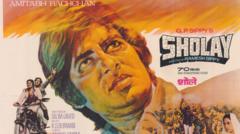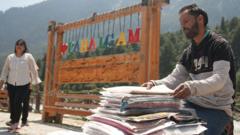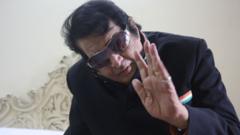The iconic 1975 film Sholay is making a triumphant return to the big screen, showcasing its original ending for the first time in 50 years at a special festival in Italy.
Sholay Returns: The Iconic Film Celebrates 50 Years with a Restored Version and Original Ending

Sholay Returns: The Iconic Film Celebrates 50 Years with a Restored Version and Original Ending
After five decades, Sholay's fully restored edition will premiere at a festival in Italy, featuring scenes that reveal its true legacy.
Fifty years since it captivated audiences, Bollywood's classic film Sholay (Embers) is returning in a stunning newly restored version that restores its original narrative integrity. Directed by Ramesh Sippy, this 1975 landmark film will have its world premiere at the prestigious Il Cinema Ritrovato Festival in Bologna, Italy, on Friday. Notably, this presentation includes the original ending—altered previously due to censorship issues—alongside previously deleted scenes.
The revival will occur on the festival’s charming open-air screen in Piazza Maggiore, one of Europe’s most magnificent settings for cinematic experiences. This epic saga features an ensemble cast led by heavyweights Amitabh Bachchan and Dharmendra, along with performances from Hema Malini, Jaya Bhaduri, Sanjeev Kumar, and the unforgettable Amjad Khan as the dreaded villain Gabbar Singh. Drawing creative inspiration from both Western and samurai genres, the film also retains its distinct Indian flavor.
With a runtime of 204 minutes, Sholay presents a gripping narrative of good battling evil set in the fictional village of Ramgarh. The storyline revolves around two small-time criminals, Jai and Veeru (portrayed by Bachchan and Dharmendra), hired by a former police officer, Thakur Baldev Singh, to eliminate the menacing bandit Gabbar Singh, an enduring figure in Indian cinematic history. Initially released in 1975, Sholay found a remarkable footing in theaters, playing for five continuous years at Mumbai’s Minerva theatre, earning accolades such as "Film of the Millennium" in a BBC online poll, and even being heralded as the greatest Indian film in a British Film Institute survey.
Cultural references to Sholay run deep in Indian society; its dialogues have become part of wedding traditions, political discourse, and even advertisements. Dharmendra recently remarked, “Sholay is the eighth wonder of the world.” Reflecting on the film's production, Bachchan, who was unaware of the film's future impact during filming, described the experience as unforgettable.
This upcoming restoration stands as the most faithful rendition of Sholay, reintegrating its original conclusion alongside previously unreleased scenes, according to Shivendra Singh Dungarpur from the Film Heritage Foundation. Originally, Gabbar Singh met his fate at the hands of Thakur when he was killed with spiked shoes. The censors, however, deemed this an excessive portrayal of violence and were uncomfortable with the former police officer taking the law into his own hands. The film encountered multiple challenges, as it was released during the Emergency in India when civil liberties were suspended.
Despite attempts to negotiate with the censor board, Sippy had no choice but to reshoot the finale in a hurry to allow the film to clear the censorship hurdles. In order to accomplish this, cast and crew had to trek back to the rugged landscapes of Ramanagaram in Karnataka, transforming it into Ramgarh once more. The reworked ending softened the film’s grim closure, as Gabbar Singh is captured instead of killed—a key change that allowed it to pass the censorship checks.
The restoration journey was intricate and arduous, with the original 70mm prints having deteriorated beyond use. A quest led by Shehzad Sippy, son of Ramesh Sippy, sought the long-forgotten elements stored in a Mumbai warehouse, eventually revealing the original 35mm camera and sound negatives. The project took an exhilarating turn as it also accessed additional crucial materials housed in the UK, working alongside the British Film Institute to transport the delicate elements to L'Immagine Ritrovata in Bologna, an esteemed restoration facility.
Notably, Sholay’s initial distribution faced uphill challenges; it initially received mixed reviews, struggled at the box office, and was even dubbed a "dead ember" by critics. Audiences remained muted during early screenings but slowly began to connect with the film as word-of-mouth success kindled interest. Subsequently, with the release of a dialogue record shortly post-premiere, the film cinched iconic status and its characters, including Gabbar Singh, became a hallmark of Indian cinema.
In a remarkable feat, Sholay ran for over five continuous years, even finding its place across the border in Pakistan decades later. Addressing its lasting impact, Bachchan succinctly described Sholay’s essence: "The victory of good over evil and poetic justice, all wrapped up in three hours—something most wouldn’t witness in a lifetime.”


















